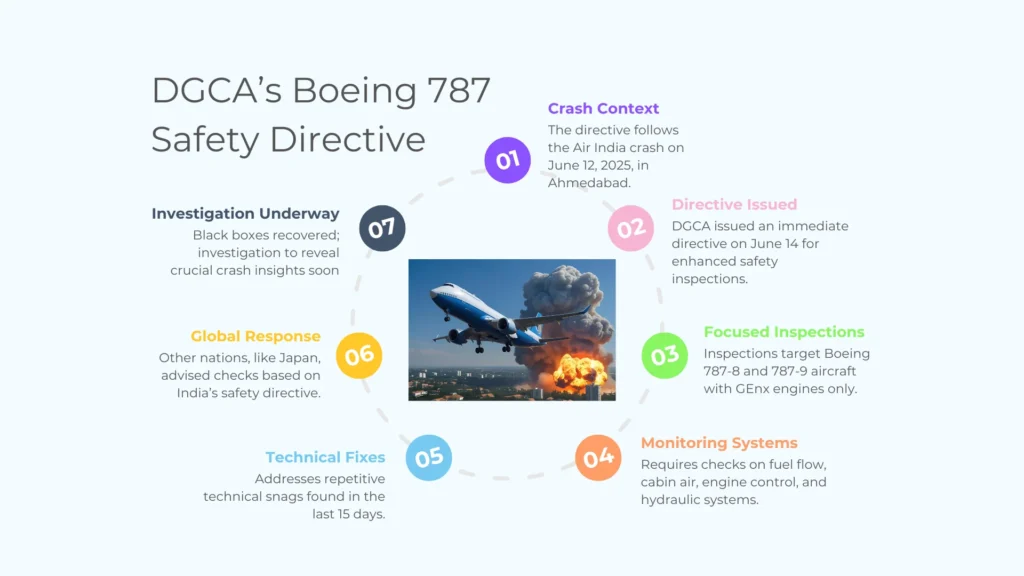Read the Safety Directive on Boeing 787 Fleet issued by DGCA after Air India Crash in Ahmedabad on 12th June 2025
Safety Directive on Boeing-Date & Context
- Date: Directive issued on June 14, 2025, a day after the Ahmedabad crash.
- Purpose: Immediate “enhanced safety inspection” of all Boeing 787-8 and 787-9 aircraft in India, especially those with GEnx engines
What the DGCA Ordered- Safety Directive on Boeing 787 Fleet
Air India must perform the following before every departure from India:
- Fuel parameter monitoring system
- Checks ensure accurate fuel flow and detect discrepancies.
- Cabin air compressor
- Ensures correct pressurisation and ventilation.
- Electronic Engine Control (EEC) unit
- Verifies engine response and health.
- Fuel-driven actuator & oil systems
- Ensures lubrication and cooling.
- Hydraulic system
- Checks landing gear, brakes, flaps, and rudder functionality.
- Flight-control inspections during each transit stop.
- Power-assurance checks within two weeks to confirm proper engine thrust.
- Review of takeoff performance data
- Flags issues with engine output, weight calculations, or environmental conditions.
- Resolve repetitive technical snags logged in the last 15 days.
All reports must be submitted to DGCA and validated by regional offices.
Fleet Affected
- Air India’s 787 fleet: 34 aircraft (787‑8 & 787‑9), average age ~8.4 years.
- Global fleet: ~1,148 Boeing 787s in service, average age ~7.5 years
DGCA focuses only on Boeing 787s with GEnx engines—same model involved in the crash.
DGCA’s Safety Directive on Boeing 787 Fleet| Black Box & Probe Update
- Black boxes (CVR + FDR) retrieved ~28 hours post-crash.
- Civil Aviation Minister confirmed recovery and noted its importance to the investigation
Leadership & Company Response
- Air India CEO Campbell Wilson visited the crash site.
- Tata Group Chairman N Chandrasekaran described it as “the darkest hour in the history of the Tata group.” He promised full transparency and a high-level probe committee.
Regulatory & International Reactions
- US Secretary of Transportation Sean Duffy warned it was too early to ground the global Boeing 787 fleet.
- Japanese authorities have asked domestic carriers to inspect their 787s following DGCA’s lead
Safety Directive on Boeing 787 Fleet
| Inspection Area | Purpose |
|---|---|
| Fuel parameter monitoring system | Ensure correct fuel flow, spot discrepancies |
| Cabin air compressor | Verify pressurisation and ventilation |
| Electronic Engine Control (EEC) | Confirm engine response health |
| Fuel actuator & oil systems | Check lubricating and cooling systems |
| Hydraulic system | Monitor landing gear, brakes, control surfaces |
| Flight-control during transit | Avoid mid-turn issues during quick stops |
| Power-assurance checks | Confirm engines deliver full thrust |
| Takeoff performance data review | Detect weight, thrust, or environment anomalies |
| Repetitive snag resolution | Fix recurring technical issues promptly |
Why It Matters
- Preventive action: Moves beyond reactive investigation to proactive inspections.
- Focused on cause: Targets systems potentially linked to engine failure or performance drop.
- Regulatory rigor: Signals DGCA’s intention to enforce strong safety standards immediately.
- Global ripple: Sets precedent; other regulators may adopt similar directives.
Story Behind the News
- Trigger Event: The sudden crash of AI‑171 on June 12 prompted urgent scrutiny of critical systems.
- DGCA response: Regulators moved fast—issuing orders 24 hours later, gathering black boxes, organizing top-level reviews.
Safety Directive on Boeing 787 Fleet: Emerging Developments

- Investigation: Black-box data may be disclosed soon.
- Fleet review: India considering Boeing 787 groundings pending results.
- Global oversight: Other civil aviation authorities may mirror India’s checks.
- Public scrutiny: Social media and media coverage keep pressure on Air India and Boeing.
Safety Directive on Boeing 787 Fleet: Summary
- DGCA issued a tight inspection directive targeting fuel, engine, hydraulic, and flight-control systems for Boeing 787s after the crash.
- It applies to every flight from India and includes both fleet-wide and departure-specific checks.
- Findings are under strict regulatory oversight, with global watchers noting India’s fast and thorough response.
- The story is evolving—with investigation results, fleet management decisions, and cross-border regulatory alignment coming next.
- DGCA

